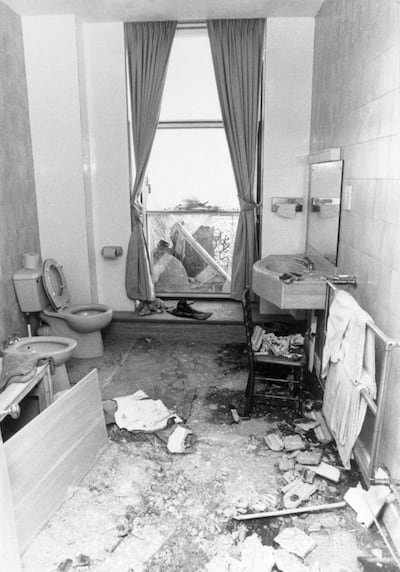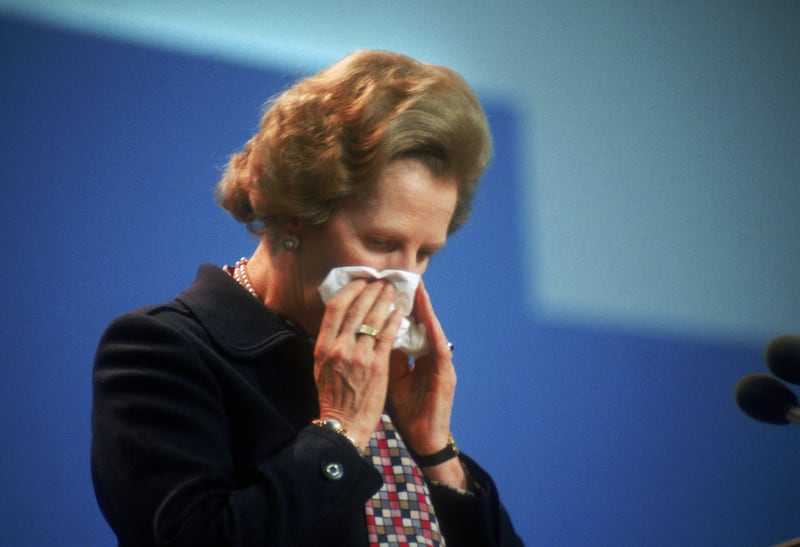
“Rejoice” declaimed Margaret Thatcher outside No 10 Downing Street, London, on April 25th, 1982, in her first media doorstep after British forces had triumphed in the 74-day Falklands War that had cost more than 900 lives.
She was more than midway through the first of her three terms as British prime minister and she was already arguably the world’s most powerful woman, lauded by US president Ronald Reagan as “the only European leader I know with balls” and glorying in the label “Iron Lady” bestowed on her by a Soviet newspaper.
Less than three months later IRA bombs targeting Falklands veterans killed 11 soldiers in London’s Hyde Park and Regent’s Park on the same day. And just over two years after that, Mrs Thatcher narrowly escaped death when the IRA bombed the Grand Hotel in Brighton, demolishing the bathroom of her first-floor suite, killing five people close to her and seriously injuring 33 others. It was a moment when “history pirouetted”, writes Dubliner Rory Carroll, Ireland correspondent of the Guardian newspaper, in this extraordinary account of how the IRA planned the Brighton bombing, who the bomber was and how he was caught.
Mrs Thatcher was still fully dressed and polishing her speech for the final day of the Conservative Party conference when the bomb exploded five floors above her at 2.54am on Friday October 12th, 1984. An IRA ‘construction engineer’ had predicted, correctly, that an explosion in a front room would bring the hotel’s roof crashing down through the floors below. “Had Thatcher been in the Napoleon Suite bathroom, or had the avalanche of rubble swerved another way, she could have died”, writes Carroll. “For want of two minutes, or a few feet, history could have turned, and with it the fate of Northern Ireland, Thatcherism, and the Cold War”.
READ MORE

One of only 25 women among the 630 MPs in the House of Commons after the 1959 general election, Mrs Thatcher became the first mother to hold government office in Britain before being elected in 1979 as Britain’s first woman prime minister and first woman head of a European government. The assassinations shortly before and after the 1979 general election of Airey Neave, probably her closest political friend, and of the war hero and British royal family relative Lord Mountbatten forced her to address for the first time the decade-old Northern Ireland ‘Troubles’.
After sending handwritten, individual letters to the families of the 18 British soldiers who were killed by the IRA at Warrenpoint, Co Down, on the same day that it murdered Mountbatten alongside an 83-year old woman friend and two teenage boys in Sligo, Mrs Thatcher flew to Belfast and Armagh to consult army and police chiefs. The army wanted to crush the IRA militarily, but the RUC chief constable Kenneth Newman persuaded her that the policy of ‘Ulsterisation’ and ‘criminalisation’ of IRA captives was working. Her acceptance of ‘police primacy’ informed her intransigence during the IRA hunger strikes of 1980 and 1981, making her the IRA’s prime target.
The IRA plot, hatched in a Ballymun flat and a Tralee pub, was not initially approved by its army council, nor was Patrick Magee the first choice to carry it out. British police had his fingerprints since his days as a juvenile offender in Norwich, where he spent some of his childhood. In his native Belfast, his IRA membership and explosives expertise led to his arrest and imprisonment in Long Kesh. The RUC, Garda Síochána, British Army and domestic and overseas intelligence agencies, MI5 and MI6, all kept files on him. In Scotland Yard, the London Metropolitan Police had two separate files on him – in the Anti-Terrorist Branch on the fifth floor and in the Special Branch on the eleventh floor.
Magee avoided extradition from the Netherlands in 1980 and dodged arrest in Blackpool in 1983 before arriving undetected in Brighton and checking into the Grand Hotel on Saturday, September 15th, 1984, the day that Princess Diana gave birth to her second son, Harry. Two people, never traced, joined him in the hotel for lunch and probably gave him the bomb components. He spent the next three days and nights mostly alone in Room 629 assembling and planting the bomb. Its long-delay timer was set at 24 days, six hours and 32 minutes.
The explosion and the carnage that followed are described in the 25 riveting and moving pages of the book’s central chapter. The detonation’s velocity – greater than a typhoon’s – toppled the hotel’s chimney stack. “Like a monstrous guillotine, it sliced through concrete, steel, and wood, all the way to the ground floor”, Carroll writes. “What saved Thatcher was the path it took ... It merely clipped those rooms, including Thatcher’s Napoleon suite, with numbers ending in 9″.
The bomb also fractured irreparably the bond between Thatcher and her closest cabinet colleague (and, at the time, most likely successor), Norman Tebbitt. She watched from a Sussex police station as he was stretchered from the wreckage in his pyjamas, live on breakfast-time TV, four hours after the blast. Overhearing her bodyguards and aides fretting about getting her safely and quickly back to London she told them: “I do not mind where you take me but there is one clear instruction. You must have me back at the Conference Centre by 9am. Is that understood?” Tebbitt never recovered from chronic pain and grief for his wife, also named Margaret, who was paralysed by the bomb, while Thatcher developed survivor’s guilt, feeling that she was responsible for his fate.

The bomb sparked the biggest manhunt in British history. Like the Thomas Hardy poem describing how the inch-by-inch construction of the Titanic was mirrored by the inch-by-inch growth of the iceberg that would sink it, the third section of this book details how Magee, having returned undetected to England, was planning a new IRA bomb blitz on 16 cities and seaside resorts while police and fingerprint experts were slowly sifting through 880 tons of rubble to find the hotel registration card bearing his tiny palm print. The security services had been lax in protecting the Grand Hotel and in monitoring Magee’s movements before October 1984, but dogged and painstaking police work in Brighton, London, Belfast, Norwich and Dublin led to his capture and imprisonment.
Magee had watched TV reports of the bombing in a safe house in Cork and had lived in Ballymun before returning to Britain to prepare, with future Sinn Féin MEP Martina Anderson and others, for the new bombing campaign from bases in London and Glasgow. He answered a knock on the door of the Glasgow apartment he shared the other gang members on a Saturday evening in June 1985 thinking it was the landlord’s routine call to collect the rent. “Can I help you?”, he asked the armed policeman confronting him. He did not get the response he expected.
Apart from Magee and Thatcher, the person who looms largest in this book is former Sinn Féin president, TD and abstentionist MP Gerry Adams. It was Adams who told Magee and others in Long Kesh that they could defeat the British if they built a political movement and retooled the IRA for a “long war”. He declined to speak to Carroll.
[ Brighton bomber and daughter of bomb victim at Galway debateOpens in new window ]
Just over two months after Mrs Thatcher, in tears, left No 10 Downing Street for the last time in November 1990, ending 11 years as prime minister, the IRA propelled an improvised mortar bomb into the back garden of No 10, her “refuge from the rest of the world”, as she described it.
The members of the IRA gang that fired that rocket, and a second mortar bomb, from a Ford Transit van parked in nearby Whitehall on February 7th, 1991, have never been identified or apprehended. Neither, as Carroll points out in this outstanding book, have any of the 30-or-so people who helped Magee to plan, manufacture and plant the bomb that came within metres of murdering Mrs Thatcher when she was “the most powerful woman in the world”.
Her survival and her anti-EU rhetoric made her a progenitor of Brexit and its unforeseen consequences for Northern Ireland, Carroll says, adding that this created “the great irony” that “it may be Margaret Thatcher’s legacy, not IRA bombs, that delivers a united Ireland”.
This speculative final paragraph aside, the book is filled with page after page of factual and fascinating information about the planning for and consequences of what almost became the deadliest of what the IRA liked to call “spectaculars”.
Carroll interviewed more than a hundred former IRA members, police detectives, bomb disposal experts, politicians, officials and friends and relatives of key players for this book. With research assistants he also mined contemporary newspapers and books for context and for the pithy quotes that litter this exhaustive and essential examination, written like a thriller, of what led to and what followed one of the most sensational events of the Troubles era.










